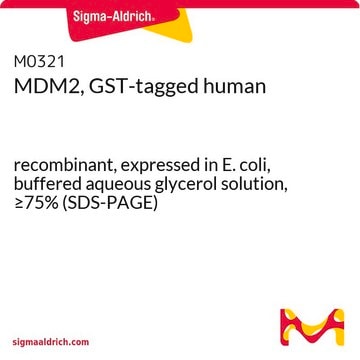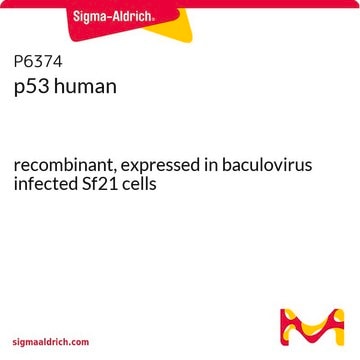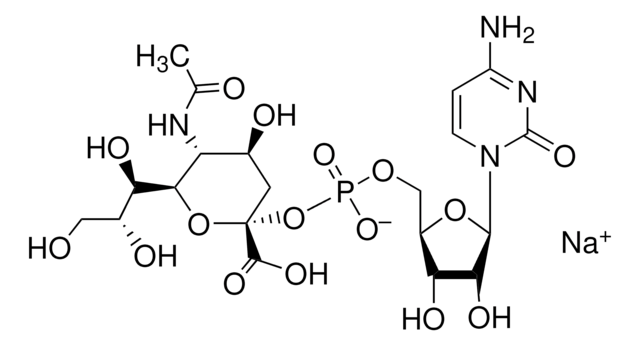SRP2095
MDM2, HIS tagged human
recombinant, expressed in E. coli, ≥80% (SDS-PAGE), buffered aqueous solution
Synonym(s):
HDMX, MGC5370, MGC71221, hdm2
Sign Into View Organizational & Contract Pricing
All Photos(1)
About This Item
UNSPSC Code:
12352200
NACRES:
NA.26
Recommended Products
biological source
human
recombinant
expressed in E. coli
tag
8-His tagged (C-terminus. )
Assay
≥80% (SDS-PAGE)
form
buffered aqueous solution
frozen liquid
mol wt
~57.8 kDa
packaging
pkg of 10 μg
concentration
350 μg/mL
color
clear colorless
NCBI accession no.
UniProt accession no.
shipped in
dry ice
storage temp.
−70°C
Gene Information
human ... MDM2(4193)
Biochem/physiol Actions
Originally discovered as one of three genes amplified on double minute chromosomes in a tumorigenic derivative of NIH 3T3 cells, MDM2 was later shown to possess oncogenic potential when overexpressed. High-level expression of MDM2 has also been shown to confer tumorigenic potential upon nontransformed rodent fibroblasts in athymic nude mice. MDM2 can immortalize rat embryo fibroblasts and can cooperate with activated RAS to transform these cells. Elevated levels of MDM2 protein have been found in a variety of human tumors, most notably in soft tissue sarcomas where up to 30% of primary tumors contain multiple copies of the MDM2 gene. One mechanism by which MDM2 overexpression promotes tumor development is through its ability to bind to the p53 tumor suppressor, thereby blocking the transactivation, cell cycle arrest, and apoptotic functions of p53. MDM2 can inhibit p53 activity in a number of ways including preventing p53 from recruiting TAFs, promoting nuclear export, inhibiting p53 acetylation, and perhaps most importantly by virtue of its function as an E3 ubiquitin ligase with specificity for, among others, p53. In addition to regulating p53 levels by targeting p53 for proteasomal degradation MDM2 also transfers ubiquitin to itself, MDMX, the ß2 adrenergic receptor, glucocorticoid receptor, TIP60, and PCAF.
Physical form
Clear and colorless frozen liquid solution.
MDM2 is stored in 20mM Tris-Cl (pH 8.0), 20% Glycerol, 100mM KCl, 1mM DTT and 0.2mM EDTA buffer.
MDM2 is stored in 20mM Tris-Cl (pH 8.0), 20% Glycerol, 100mM KCl, 1mM DTT and 0.2mM EDTA buffer.
Preparation Note
Use a manual defrost freezer and avoid repeated freeze-thaw cycles. While working, please keep sample on ice.
Storage Class Code
10 - Combustible liquids
WGK
WGK 1
Flash Point(F)
Not applicable
Flash Point(C)
Not applicable
Certificates of Analysis (COA)
Search for Certificates of Analysis (COA) by entering the products Lot/Batch Number. Lot and Batch Numbers can be found on a product’s label following the words ‘Lot’ or ‘Batch’.
Already Own This Product?
Find documentation for the products that you have recently purchased in the Document Library.
C A Finlay
Molecular and cellular biology, 13(1), 301-306 (1993-01-01)
Expression of a p53-associated protein, Mdm-2 (murine double minute-2), can inhibit p53-mediated transactivation. In this study, overexpression of the Mdm-2 protein was found to result in the immortalization of primary rat embryo fibroblasts (REFs) and, in conjunction with an activated
L Cahilly-Snyder et al.
Somatic cell and molecular genetics, 13(3), 235-244 (1987-05-01)
We are exploring the origin and function of amplified DNA sequences associated with double minutes (DMs) in a spontaneously transformed derivative of mouse 3T3 cells. Toward that goal, we have constructed a cDNA library using RNA from these cells and
S S Fakharzadeh et al.
The EMBO journal, 10(6), 1565-1569 (1991-06-01)
We have carried out an analysis of amplified DNA sequences present in a tumorigenic mouse cell line, designated 3T3DM, to determine if the presence of cellular transforming activity is correlated with the elevated expression of any of the amplified genes.
Our team of scientists has experience in all areas of research including Life Science, Material Science, Chemical Synthesis, Chromatography, Analytical and many others.
Contact Technical Service








